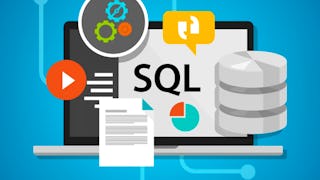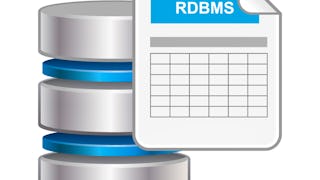This course is an introduction to how to use relational databases in business analysis. You will learn how relational databases work, and how to use entity-relationship diagrams to display the structure of the data held within them. This knowledge will help you understand how data needs to be collected in business contexts, and help you identify features you want to consider if you are involved in implementing new data collection efforts. You will also learn how to execute the most useful query and table aggregation statements for business analysts, and practice using them with real databases. No more waiting 48 hours for someone else in the company to provide data to you – you will be able to get the data by yourself!

Gain next-level skills with Coursera Plus for $199 (regularly $399). Save now.

Managing Big Data with MySQL
This course is part of Excel to MySQL: Analytic Techniques for Business Specialization


Instructors: Daniel Egger
192,458 already enrolled
Included with
(4,085 reviews)
Skills you'll gain
Details to know

Add to your LinkedIn profile
5 assignments
See how employees at top companies are mastering in-demand skills

Build your subject-matter expertise
- Learn new concepts from industry experts
- Gain a foundational understanding of a subject or tool
- Develop job-relevant skills with hands-on projects
- Earn a shareable career certificate

There are 6 modules in this course
The Coursera Specialization, "Managing Big Data with MySQL" is about how 'Big Data' interacts with business, and how to use data analytics to create value for businesses. This specialization consists of four courses and a final Capstone Project, where you will apply your skills to a real-world business process. You will learn to perform sophisticated data-analysis functions using powerful software tools such as Microsoft Excel, Tableau, and MySQL. To learn more about the specialization, please review the first lesson below, "Specialization Introduction: Excel to MySQL: Analytic Techniques for Business." In this fourth course of this specialization, "Managing Big Data with MySQL” you will learn how relational databases work and how they are used in business analysis. By the end of this course, you will have a clear understanding of how relational databases work and have a portfolio of queries you can show potential employers. Businesses are collecting increasing amounts of information with the hope that data will yield novel insights into how to improve businesses. Analysts that understand how to access this data – this means you! – will have a strong competitive advantage in this data-smitten business world. To get started with this course, you can begin with, "Introduction to Managing Big Data with MySQL." Please take some time to not only watch the videos, but also read through the course overview as there is extremely important course information in the overview.
What's included
3 videos6 readings
In this module, you will learn how relational databases are organized, and practice making and interpreting Entity Relationship (ER) diagrams and relational schemas that describe the structure of data stored in a database. This week’s exercises are donated from a well-known Database Systems textbook, and will help you deepen and strengthen your understanding of how relational databases are organized. This deeper understanding will help you navigate complicated business databases, and allow you to write more efficient queries. At the conclusion of the week, you will test your understanding of database design principles by completing the Week 1 graded quiz. To get started, please begin with the video “Problems with Having a Lot of Data Used by a Lot of People.” As always, if you have any questions, post them to the Discussions. I hope you enjoy this week's materials!
What's included
9 videos6 readings1 assignment
In this module, you will start interacting with business databases. You will write SQL queries that query data from two real companies. One data set, donated from a local start-up in Durham, North Carolina called Dognition, is a MySQL database containing tables of over 1 million rows. The other data set we'll learn about was donated from a national US department store chain called Dillard’s, is a Teradata database containing tables with over a hundred million rows. Make sure to watch the instructional videos about how to use the database interfaces we have established for this course, and complete the MySQL exercises. At the end of the week, you will test your understanding of the SQL syntax introduced this week by completing the graded quiz. As always, if you have any questions, post them to the Discussions. Enjoy this week's materials!
What's included
6 videos5 readings2 assignments4 ungraded labs
In this module, we are going to learn the SQL syntax that allows you to segment your data into separate categories and segment. We are also going to learn how to combine data stored in separate tables. Make sure to watch the videos about joins, and complete the MySQL exercises. At the end of the week, you will test your understanding of the SQL syntax introduced this week by completing the graded quiz. We strongly encourage you to use the course Discussions to help each other with questions.
What's included
6 videos5 readings1 assignment5 ungraded labs
In this module, you will practice integrating the SQL syntax you’ve learn so far into queries that address analysis questions typical of those you will complete as a business data analyst. Due to the extensive nature of the queries we will practice this week, we have put the graded quiz that tests your understanding of the SQL strategies you will practice in its own module at the end of this week. Make sure to complete the MySQL exercises, and we strongly encourage you to use the course Discussions to help each other with questions.
What's included
2 videos5 readings4 ungraded labs
This module contains the final graded quiz for the course. This quiz are intended to hone and build your understanding of the last important concepts in the course!
What's included
1 video1 reading1 assignment
Earn a career certificate
Add this credential to your LinkedIn profile, resume, or CV. Share it on social media and in your performance review.
Instructors


Offered by
Explore more from Data Analysis
 Status: Preview
Status: Preview Status: Free Trial
Status: Free Trial Status: Free Trial
Status: Free Trial
Why people choose Coursera for their career




Learner reviews
4,085 reviews
- 5 stars
78.38%
- 4 stars
16.96%
- 3 stars
2.74%
- 2 stars
0.88%
- 1 star
1.02%
Showing 3 of 4085
Reviewed on Nov 20, 2016
very detailed introduction of SQL. The only thing is that there could be more videos introduce different functions instead of writing documents as materials. Other than that, it's a great class
Reviewed on Mar 30, 2020
Not only it teaches you how to use MySQL and Teradata in a technical perspective, it also practice the analytical mind and how you would treat a real life dataset when doing analytical work.
Reviewed on May 26, 2020
it was relatively time taking course for me but one who keeps on wins at the end.Thank You professor,duke university and coursera for providing such a wonderful course. Strongly Recommended

Open new doors with Coursera Plus
Unlimited access to 10,000+ world-class courses, hands-on projects, and job-ready certificate programs - all included in your subscription
Advance your career with an online degree
Earn a degree from world-class universities - 100% online
Join over 3,400 global companies that choose Coursera for Business
Upskill your employees to excel in the digital economy
Frequently asked questions
No. Completion of a Coursera course does not earn you academic credit from Duke; therefore, Duke is not able to provide you with a university transcript. However, your electronic Certificate will be added to your Accomplishments page - from there, you can print your Certificate or add it to your LinkedIn profile.
To access the course materials, assignments and to earn a Certificate, you will need to purchase the Certificate experience when you enroll in a course. You can try a Free Trial instead, or apply for Financial Aid. The course may offer 'Full Course, No Certificate' instead. This option lets you see all course materials, submit required assessments, and get a final grade. This also means that you will not be able to purchase a Certificate experience.
When you enroll in the course, you get access to all of the courses in the Specialization, and you earn a certificate when you complete the work. Your electronic Certificate will be added to your Accomplishments page - from there, you can print your Certificate or add it to your LinkedIn profile.
More questions
Financial aid available,


